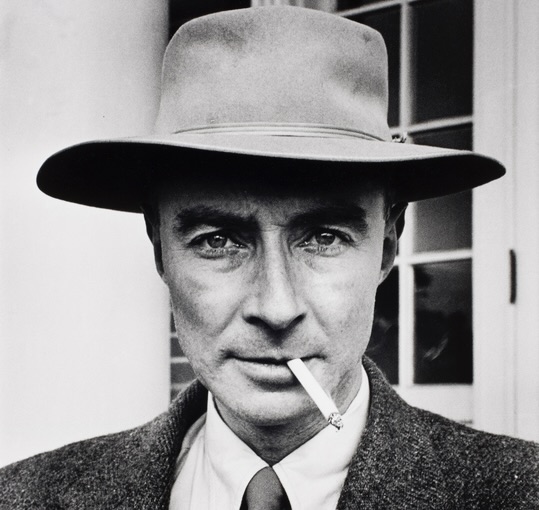
Robert Oppenheimer is everywhere these days, thanks to the blockbuster film directed by Christopher Nolan and the outstanding acting by Cillian Murphy, Emily Blunt, and Robert Downey, Jr. For most Americans, Cillian Murphy is now going to be what they “see” when they think of Robert Oppenheimer. The actor’s metamorphosis into the brilliant and complicated physicist is masterful. Murphy gets the tilt of the head right, the downcast eyes right, the gestures right, his slightly hesitating manner of speaking right, and it is said he limited his food consumption during production to a single almond per day to maintain the kind of extreme leanness of Oppenheimer.
I hope everyone will spend some time looking at photographs of J. Robert Oppenheimer. There are hundreds available at Google Images.
Oppenheimer was a fabulous subject to photograph. He was a man of many moods. He had an enormously expressive face. There was something unusual about his visage that calls up adjectives like “elfin,” “eerie,” “ethereal,” “bemused,” even “alien.” We all develop a photographic persona, a manner of posing, a “look,” and Oppenheimer, who lived so much of his life as the invariable center of attention, knew how, as one of his favorite poets, T.S. Eliot, put it, to prepare a face to meet the faces that he met.
Here are a few of the best photographs of Robert Oppenheimer.
Vindication, 1963
One of my favorite of all the thousands of photographs taken of Oppenheimer was made in the spring of 1963 when he was informed by the White House that he was to be awarded the prestigious Enrico Fermi Award. He was 59 years old. He had been disgraced nine years earlier when the Cold War military industrial establishment withdrew his security clearance. There had been years of domestic exile at the Institute for Advanced Study at Princeton. He had suffered grievously.

When he heard the news of the award, Oppenheimer called his Princeton neighbor and friend Ulli Steltzer (1923-2018), to come over and take his picture. Born in Frankfurt, Germany, in 1923, Steltzer moved to Princeton, New Jersey in 1953, and immediately began taking photographs of the local worthies, of whom there were plenty at the university and the Institute for Advanced Studies, America’s equivalent to Oxford’s All Souls College. She went on to become an important photographer of the Civil Rights Movement in the United States and Indigenous peoples, mostly in Canada. She relocated to Vancouver, British Columbia, in 1972.
Steltzer’s Oppenheimer looks like a man who has been vindicated. He is calm, confident, looking down and forward at the same time. He is rail thin, wearing an elegant three-piece suit, and as usual is holding his pipe, this time in his left hand. Oppenheimer is perfectly groomed, a gentleman of science. He looks as if he is still processing the telephone call informing him of the award, which was to be presented to him by President John F. Kennedy on December 2, on the anniversary of the first successful chain reaction, in Chicago, in 1942.
There is no note of triumph here. It’s almost as if we see him “placing” this vindication in the long crisis of his career. His mind is visibly at work. He is elegant, self-contained, reflective. Questions: how many exposures did Ms. Steltzer take that day? Did he or Steltzer choose the final image? Steltzer told a historian that she had taken Oppenheimer’s picture four times over the years. “The first time I was so excited that all the pictures were out of focus. … He was shy of the camera, and I never got more than 12 shots. … He asked me to come and take the picture at different times and occasions, but I never stayed longer than eight or 10 minutes because he would soon say that it was enough.”
The Brilliance and Whimsy of Philippe Halsman
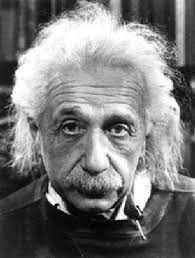
Philippe Halsman (1906-1979) took two amazing photographs of Oppenheimer. Born in today’s Latvia, then a part of the Russian Empire, in September 1928 he was sentenced to four years in prison for murdering his father, though he professed his innocence. The evidence was circumstantial. Pardoned in 1930, he relocated in France, where he became a celebrated portrait photographer.
In 1947, Halsman took one of the finest photographs of Albert Einstein. In doing so, he essentially locked in the world’s permanent impression of Einstein — wild hair, the knitted brow, the sense that he carried the whole relativistic world on his shoulders. Halsman said the photograph embodied Einstein’s regret that he had had anything to do with the dawning of the epoch of nuclear weapons.
Halsman brought his family to America in 1940. In fact, Einstein helped Halsman get an emergency visa.

Halsman took two remarkable photographs of Robert Oppenheimer. His formal portrait of Oppenheimer staring right into the camera, holding his pipe in his right hand but with the stem in his mouth, and a black chalkboard behind him with mathematical symbols in chalk, may be the single most iconic photograph of the “Father of the Atomic Bomb.” The left side of Oppenheimer’s lean face is partly in shadow. There is sorrow in his face. His eyes are a little watery. There is pride too, and an intense purposefulness. This is the portrait of a man with profound worldly cares. His right hand is holding the pipe delicately, and yet you can see tension in his beautiful fingers. His ears are pointy like Mr. Spock’s from Star Trek. His hair is thin and a little grizzled, as if he too has been radiated. This looks like the portrait of the man who created a weapon of mass destruction and now has to spend the rest of his life bearing that burden. Take the pipe away or the math squibs on the blackboard, you get the same visage but not the same significance.
Halsman also took a photograph of Oppenheimer in the same room, jumping. Yes. Jumping. In the 1940s Halsman got it into his head that by taking photographs of prominent people jumping up he would reveal their character. “Every face I see seems to hide the mystery of another human being,” he said. “When you ask a person to jump, his attention is mostly directed toward the act of jumping and the mask falls so that the real person appears.”
Once Halsman settled on this idea, he somehow talked a wide range of important people into jumping for him. It makes sense for Jerry Lewis and Dean Martin to be seen jumping, but how did he talk the stuffy Duke and Duchess of Windsor into elevating before his lens? Or Richard Nixon? His finest jump photos feature Marilyn Monroe, Sophia Loren, Liberace, Audrey Hepburn, Jackie Gleason, and Shirley MacLaine.
His most famous jump photo is entitled Dali Atomicus. It was taken in 1948. It features Salvador Dali jumping, paintbrush in hand, surrounded by a levitating easel, three flying cats, a cascade of water, and a flying chair. It took 28 time consuming takes before Halsman got the image he wanted. The photograph embodies Dali’s surrealist view of the world. It is a masterpiece in a world before Photoshop.

It’s hard to imagine Halsman talking the famously self-possessed Oppenheimer into jumping for the camera. The result is not one of Halsman’s finest jump photos, but it somehow captures the soul of Oppenheimer.

It should not surprise us that Oppenheimer even manages to jump elegantly. His suitcoat is blousing around him. His legs are as straight as a gymnast’s. His right arm is pointing straight up, his finger almost touching the ceiling, and his left arm hangs down, a finger pointed toward the floor. This is one of those rare photographs in which we do not see Oppenheimer’s amazingly expressive face, but Halsman is right that it reveals Oppenheimer clearly and says a great deal about the man.
With Einstein
Oppenheimer and Albert Einstein were never close. For one thing, Einstein was 25 years older than Oppenheimer. Einstein was deeply skeptical of quantum physics; Oppenheimer embraced the new physics and brought quantum theory to Berkeley. It is important to remember, too, that Einstein’s major work was finished by 1920, when Oppenheimer was merely 16 years old. Einstein had nothing to do with the actual creation of atomic weapons (except his famous 1939 letter to FDR), unless you remember that the power of the atomic bomb was the ultimate proof and application of the most famous equation in the history of science, Einstein’s E = MC2.
Although Einstein was persuaded by Leo Szilard to send his “new developments in physics” letter to President Roosevelt on August 2, 1939, he was a lifelong pacifist. As the scientific triumph of the splitting of the atom transmogrified into the nuclear nightmare of Hiroshima, Nagasaki, and the Cold War, with its Mutually Assured Destruction (MAD), Einstein began to distance himself from the Szilard letter and from his own agency in alerting America’s wartime president of the possibility of an atomic bomb. Einstein’s elusiveness on this issue — some said his caginess — caused some of his colleagues to lose respect for him. He genuinely regretted what he had done, but Szilard, Teller, and others, including Robert Oppenheimer, believed that there had been an absolute imperative for the United States to beat Adolf Hitler to the atomic bomb. One only has to ask what Hitler would have done with the bomb, had Heisenberg made him one, at Moscow or Stalingrad, or as a revenge bombing of London when it was clear that the war was lost. Einstein also knew that, but in the eyes of some he glided away from the implications of the weapon he helped to birth.
The August 1939 Szilard-Einstein letter warned President Roosevelt that “the element uranium may be turned into a new and important source of energy in the immediate future. Certain aspects of the situation which has arisen seem to call for watchfulness and if necessary, quick action on the part of the Administration. … This new phenomenon would also lead to the construction of bombs, and it is conceivable — though much less certain — that extremely powerful bombs of this type may thus be constructed. A single bomb of this type, carried by boat and exploded in a port, might very well destroy the whole port together with some of the surrounding territory.”
The Oppenheimer film invents two meetings between Oppenheimer and Einstein: one, early on, about the possibility that the atomic device might ignite the nitrogen in the atmosphere and destroy the world, in which Oppenheimer asks Einstein to work the calculations. The other, at the end of the film, features a conversation in 1947 (that never happened) in which Oppenheimer tells Einstein ruefully that the arms race precipitated by the invention of atomic weapons might very well be the “chain reaction” that destroys life on earth. None of this is grounded in historical evidence.
It is true that when Oppenheimer was crushed by the paranoia and mania of the Cold War, Einstein suggested that he might just wish to repudiate a nation that would treat him so cruelly and relocate in Europe. They were colleagues at the Institute for Advanced Study in Princeton. Their friendship — if it can justly be called that — didn’t really get traction until the 1960s in New Jersey. Einstein said, “The trouble with Oppenheimer is that he loves a woman who doesn’t love him — the United States government.”
In this clearly posed photograph, a very respectful Oppenheimer listens intently as a more cheerful Einstein explains something to him. Einstein is his usual disheveled self. Every day was a bad hair day for Albert Einstein. Oppenheimer is buttoned up as usual. It is clear from the composition of the photograph that Einstein is the international celebrity and Oppenheimer the respectful acolyte. Oppenheimer’s powers of concentration were legendary.
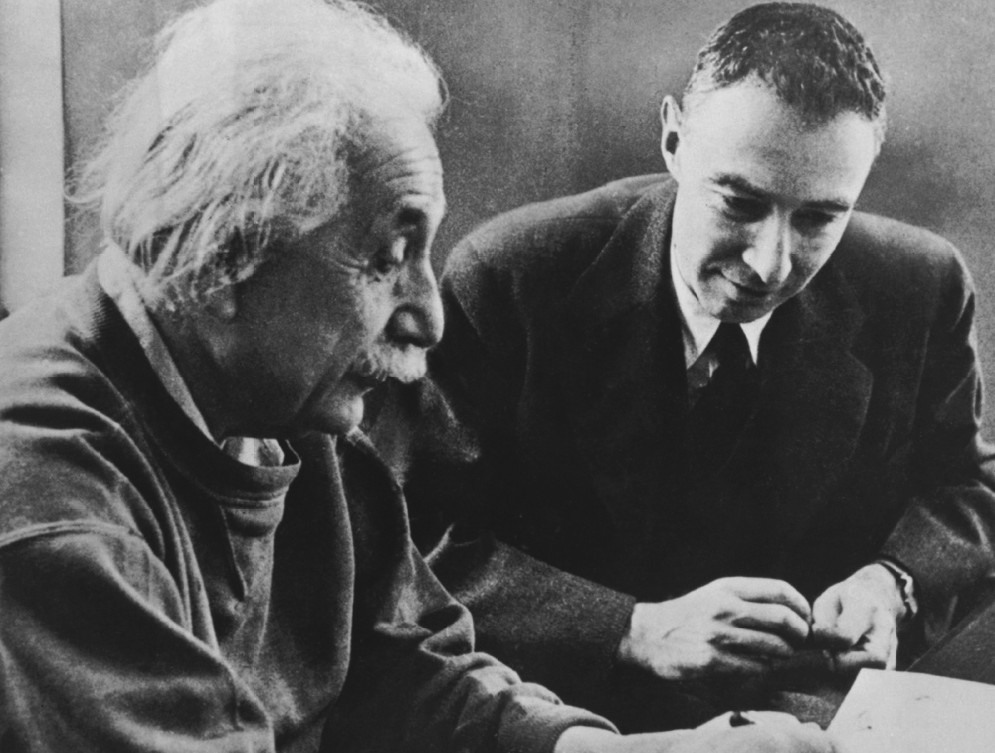
The Man of Sorrows: The Genius of Alfred Eisenstaedt
My favorite photograph of Oppenheimer is one that I have framed and displayed in my house in North Dakota. Every time I gaze at it I am sucked into the vortex of Oppenheimer’s greatness and his status as a genuinely tragic figure.
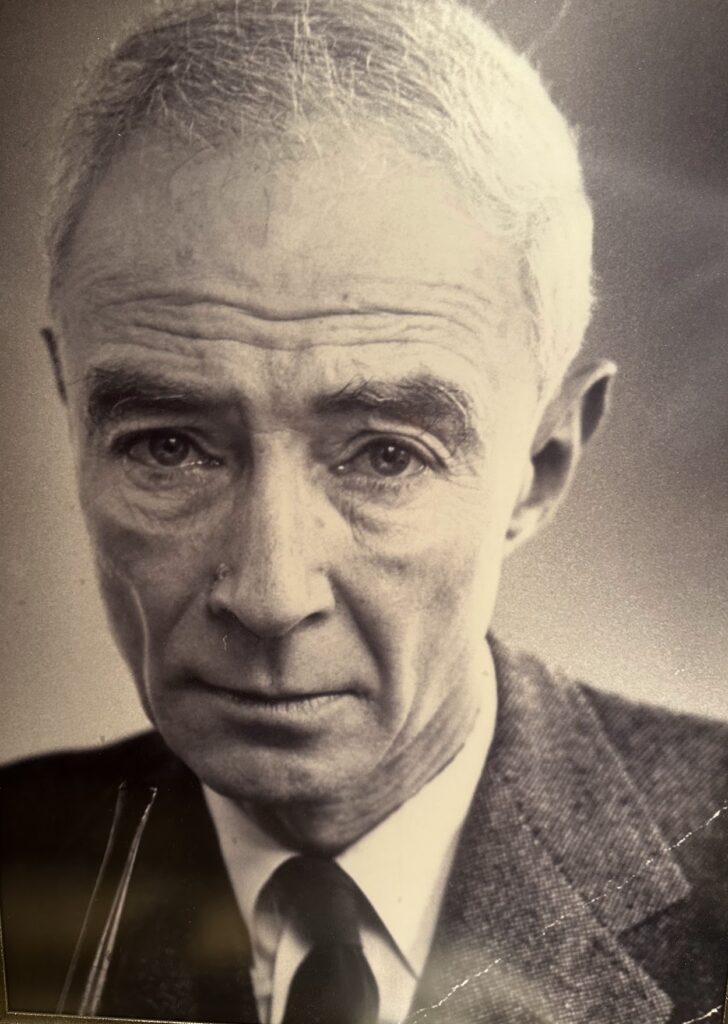
This haunting photograph was taken by Alfred Eisenstaedt (1898-1995), one of the great photographers of the 20th century. Eisenstaedt is best known for his photographs of Marilyn Monroe, Sophia Loren, and Einstein, and for the iconic image of a sailor kissing a nurse in Times Square on V-J Day in 1945. More than a hundred of Eisenstaedt’s photographs graced the cover of Life magazine. One of my personal favorites shows a uniformed drum major practicing his high-kicking prance on the University of Michigan campus, as children march behind him, attempting to imitate his lurching legs. It’s the stuff of the 1962 film, The Music Man. It makes you long for a lost age of innocence in America.
This photograph is the ultimate portrayal of Oppenheimer the Man of Sorrows. It speaks for itself. It’s as if Oppenheimer is carrying not just Hiroshima and Nagasaki and the threat of nuclear apocalypse on his shoulders, in his brain and heart and soul, but also the Battle of the Marne, Auschwitz, Dresden, Tokyo, the Great Ukrainian Famine (1932-33), Bataan, Iwo Jima, My Lai, and Abu Ghraib. One of the themes of Oppenheimer is eros and thanatos, the paradoxical union of the life principle and the death principle. When Oppenheimer famously said, “I am become Death, the destroyer of worlds,” at the moment of his greatest intellectual and scientific achievement, he was drilling down into the incredible core problem of our species. All that genius, all that madness. All that progress, all that destruction. One of the greatest geniuses in modern history, the inventor of a weapon that vaporized scores of thousands of innocent people instantaneously. The triumph of mind, the surrender to bestiality. There is no final resolution of the problem of J. Robert Oppenheimer.
The Eisenstaedt masterpiece has been hanging in my bedroom for the last 10 years — well, until now. My daughter was visiting. She stepped into my bedroom and said, “What do you think the chances are that you ever again have a date, Dad?” I moved the heavy frame down to my basement library.
Oppenheimer on NBC

No survey of the Oppenheimer images is complete without screenshots (not photographs) of his 1965 appearance on NBC on the 20th anniversary of Hiroshima and Nagasaki. This is the famous moment when the phrase, “I am become Death, the destroyer of worlds” first became the eight-words-that-sum-up J. Robert Oppenheimer and the creation of the atomic bomb. We know that Oppenheimer did not actually utter those words at dawn on July 16, 1945, at Alamogordo, New Mexico, when the “gadget,” as it was called, was successfully tested for the first time. Just when that passage from the Bhagavad Gita first became for Oppenheimer the matrix for his narrative of the thing he had done is unclear.
He was a great physicist but an equally devoted student of the humanities. He learned Italian to read Dante’s Divine Comedy in the original, and he learned some Sanskrit so that he could read the Hindu sacred texts. Here’s a paradox: the tragedy of J. Robert Oppenheimer is that he was so well educated, so deeply read not just in Western traditions but world culture, so intricately wired in ethical consciousness, so densely cultured, that he brought to his great technological achievement a soul too complicated for the leaders of the country he served. What Teller said of Oppenheimer at the security hearing in 1954 articulated what most people who knew him felt at one time or another, that “his actions, frankly, appeared to me confused and complicated.”

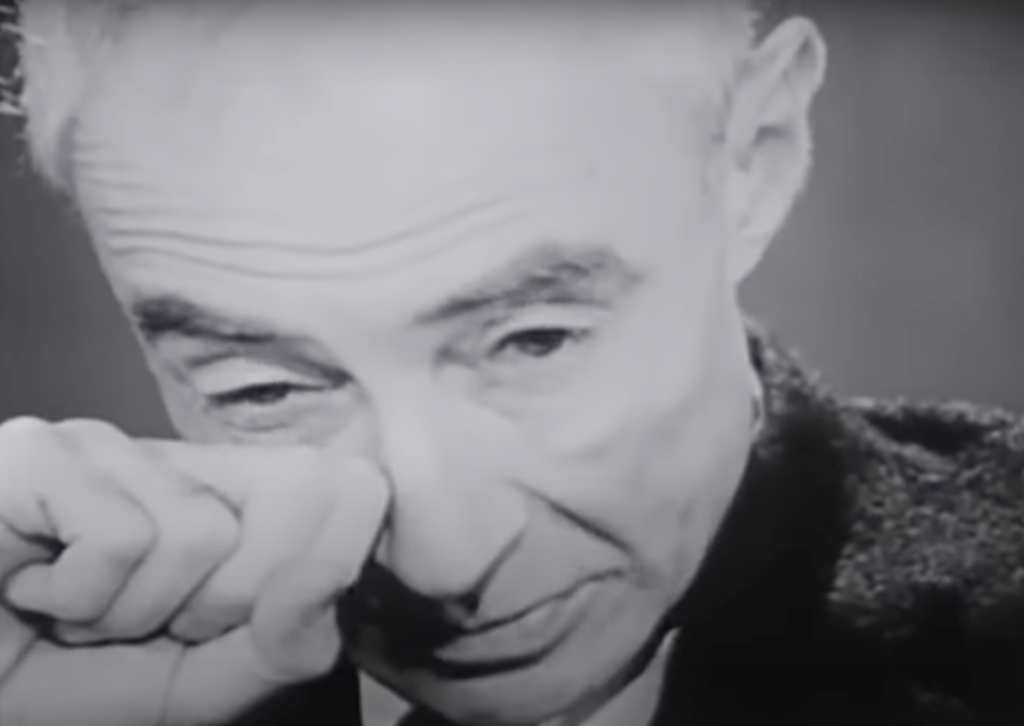
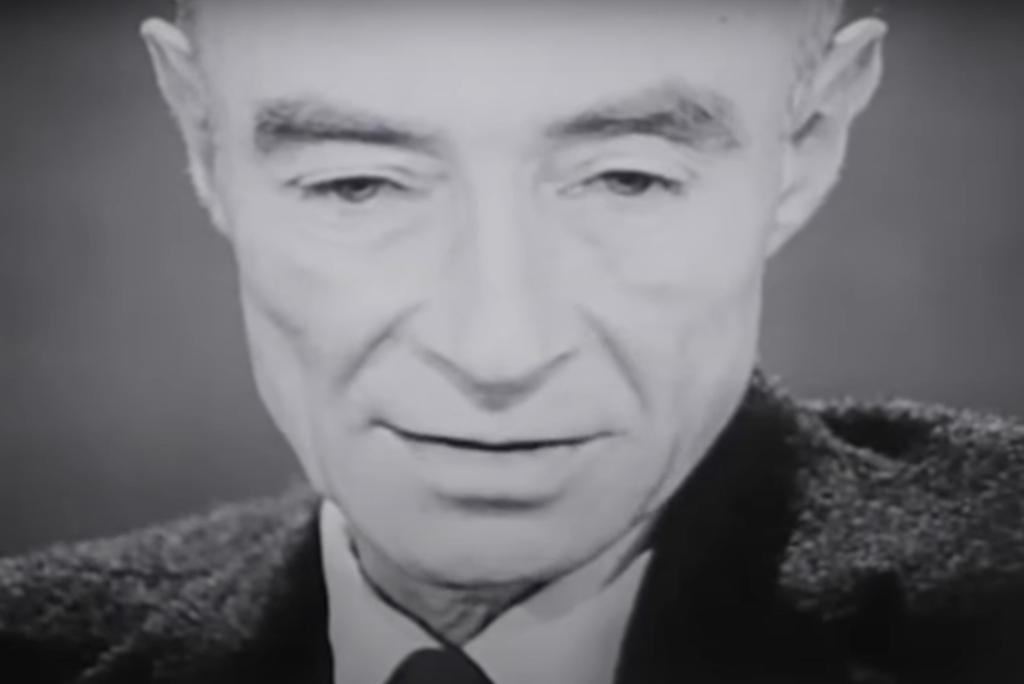
In 1965, on the anniversary of the great atomic summer of 1945, Oppenheimer brought his most fully matured narrative to the cameras of NBC News. He looked haunted. He was desperately thin. The cancer that would kill him was already ravaging his frail body. This was the Oppenheimer of the last years, vindicated by the Kennedy administration, but never again granted a security clearance. This was just three years after the horrifying Cuban Missile Crisis of October 1962, when the world edged as close to the abyss as it ever has since the invention of the bomb. This was just two years after the assassination of JFK, one of the most shattering events of the postwar era. This was not the Robert Oppenheimer of July 17, 1945, when he returned from the Trinity test and cupped his hands over his head in a gesture of unambiguous triumph.
Here’s what he said on NBC:
We knew the world would not be the same. A few people laughed, a few people cried, most people were silent. I remembered the line from the Hindu scripture, the Bhagavad-Gita. Vishnu is trying to persuade the Prince that he should do his duty and to impress him takes on his multi-armed form and says, “Now, I am become Death, the destroyer of worlds.” I suppose we all thought that one way or another.
One question that hovers over Oppenheimer is how much of what he did was a pose? Don’t get me wrong. I regard Oppenheimer as a great man, an American hero, and an authentic leader who had the gall to question not only what the United States was doing with the invention he helped create, but to spend the last 22 years of his life brooding over his own agency in the creation. The burden did not destroy him or paralyze him. But there could not have been more than a few hours in those two decades when he did not remember and reflect that he had been the father of the atomic bomb. How do you live with that? Whatever narrative you choose — if I hadn’t done it, somebody else would have stepped up; scientists show what’s possible, it’s the policy makers who decide what to do with it; the bomb saved lives; the bomb was so terrible that perhaps the world will know enough to stay away from the abyss — you remain the man who made it happen. Nor did Truman’s famous Oval Office rebuke — “he may have built the bomb, but I’m the one who fired it off” — lift the burden from Oppenheimer’s shoulders.
The Oppenheimer film asks the same question. To what degree did Oppenheimer self-fashion himself in the post Nagasaki world as the Man of Sorrows? To what extent did he shape himself as the world’s atomic alchemist, the sorcerer’s apprentice, the atomic scapegoat, who would take on civilization’s guilt for the promethean hubris of toying with the internal dynamics of the universe? In the film Kitty asks, “Did you think if you let them tar and feather you, the world would forgive you?” She was referring to the Soviet-style kangaroo court that stripped his security clearance in 1954. Oppenheimer’s reply was perfect (in the film), “We’ll see.”
Without in any way wanting to question the agonies of Robert Oppenheimer, I believe there is sometimes a whiff of moral posturing in his public face after 1945. This is what caused a number of intelligent and responsible individuals to feel uneasy about him at times. Nobody doubts his sincerity or his agonies.
But there is some little radiation of anxiety about the way he prepared his face to meet the faces that he met.
